If members are unable to reach a mutually agreed solution they can submit their disagreement to further procedures to obtain rulings on the consistency of the challenged measures with WTO agreements and resolve their dispute.
back to top
Requests for consultations
Disputes are initiated through a formal request for consultations, whereby the complaining member invites the member whose measures are being challenged to discuss the disputed matter, with a view to resolving it without recourse to further litigation. These requests are circulated to all WTO members.
Between the entry into force of the WTO on 1 January 1995 and 31 December 2023, a total of 621 requests for consultations were circulated to the WTO membership.
During that period, 53 WTO members initiated at least one dispute, and 61 members were a respondent in at least one dispute. In addition, a total of 90 members have participated as third parties in proceedings between two or more other WTO members. Overall, a total of 111 members have been active in dispute settlement, as a party or a third party.
Chart 1: Participation of WTO members in dispute settlement (1995 – 2023)
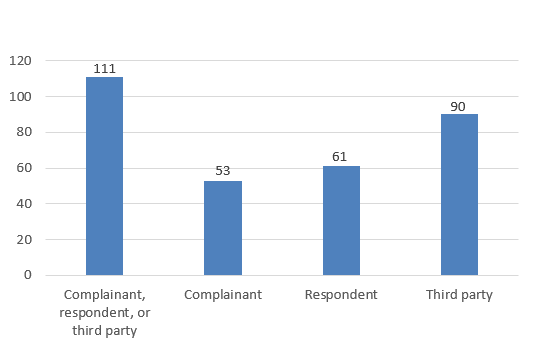
Chart 2: Requests for consultations (1995 – 2023)
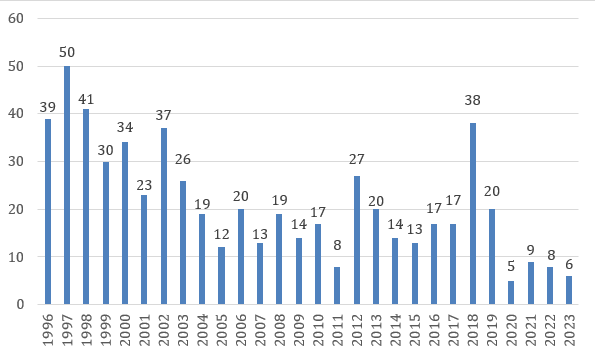
Technical note to Chart 2
Disputes are initiated by a request for consultations addressed to the member whose measures are being challenged. Every request for consultations is circulated with a “DS” number, which serves to identify the dispute throughout its successive stages.
For the purposes of this chart, and without prejudice to any legal implications that may be attached to the use of certain terminology, the term “dispute” refers to a matter identified by a distinct “DS” number. Where several Members have made a joint request in a single document, and the joint request is assigned one “DS number”, this is counted as one “dispute”. Complaints initiated through distinct requests by various Members, and individually assigned “DS” numbers, are counted as distinct disputes, even if they relate to the same matter.
Disputes to date have concerned claims under a broad range of WTO agreements, as illustrated in Chart 3 below.
Chart 3: Agreements raised in WTO disputes (1995-2023)
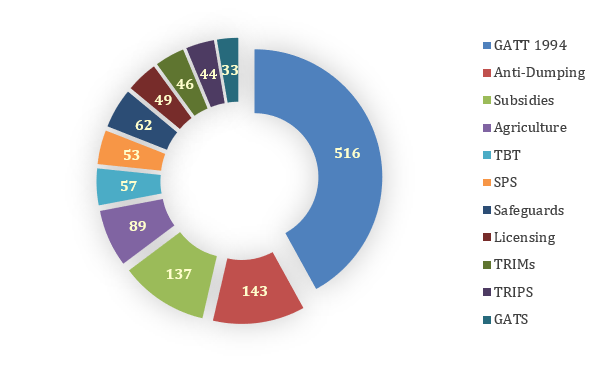
The WTO dispute settlement system is “integrated”, such that several agreements can be at issue in the same dispute. The total numbers in the chart above therefore exceed the total number of distinct disputes initiated. In cases involving trade in goods, the GATT 1994 is frequently invoked alongside more specific agreements, which explains why it appears in 516 of the 621 disputes initiated between 1995 and 2023.
back to top
Original panel and Appellate Body proceedings
Where the parties are unable to reach a mutually agreed solution through consultations, the complaining member can request the establishment of a panel to examine the matter, and either party can later appeal the rulings of the panel.
As of 31 December 2023, a panel had been established in respect of 372 disputes (that is, in 60% of all disputes initiated). This led to panel reports in 290 of these disputes (not all cases in which a panel is established result in a panel report, as the parties might settle their dispute even after a panel has been established). This was followed by an appeal in 191 disputes (that is, an appeal was notified in 66 per cent of all cases in which a panel report was circulated in the original proceedings).
Since December 2019, the Appellate Body has not been able to form Divisions of 3 Appellate Body members to hear further appeals due to the fact that Appellate Body members whose terms had expired have not been replaced.(1) As of December 2023, appeals in 30 proceedings were pending before the Appellate Body and cannot be further advanced until new members are appointed.
Chart 4 shows the number of disputes brought to the WTO and recourse to a panel and the Appellate Body, on a yearly basis, from 1995 to 2023:
Chart 4: Number of disputes initiated, original panels established and notifications of appeal in original proceedings
1 January 1995 – 31 December 2023
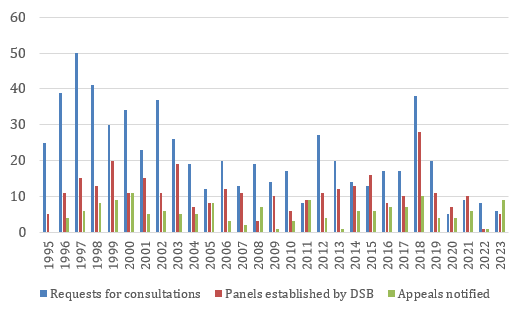
Technical note to Chart 4
Disputes are initiated through a request for consultations addressed to the member whose measures are being challenged. Every request for consultations is circulated with a “DS” number, which serves to identify the dispute throughout its successive stages.
For the purposes of this chart, and without prejudice to any legal implications that may be attached to the use of certain terminology, the term “dispute” refers to a matter identified by a distinct “DS” number. Where several members have made a joint request in a single document and the joint request is assigned one “DS number”, this is counted as one “dispute”. Complaints initiated through distinct requests by various members, and individually assigned “DS” numbers, are counted as distinct disputes, even if they relate to the same matter.
The number of panels established and appeals in this chart also relates to the number of distinct disputes (each identified by a distinct “DS” number) in respect of which a panel has been established, or an appeal has taken place. The total number of panels established would be lower if counted on the basis of distinct “matters” because a single panel can be established to examine a number of disputes together where they relate to the same matter. See the detailed explanations on groupings. of cases in the box below.
In the absence of a functioning Appellate Body, some members have resorted to an alternative appeal mechanism based on arbitration proceedings under Article 25 of the DSU. As of 31 December 2023, parties to 12 disputes have agreed on procedures for such review of panel reports and arbitrators have issued awards in two such proceedings.
back to top
Implementation period
Where procedures lead to a determination that the challenged measures are not in conformity with the WTO agreements, the Dispute Settlement Body (DSB) recommends that the member concerned brings the measures into conformity with its obligations. At that stage, the member concerned may ask for a reasonable period of time to implement the recommendations. Parties may agree on how much time the member should be given to remove the inconsistency, or, if the parties do not reach an agreement, arbitration can take place to determine what would be a reasonable period for implementation.
As of 31 December 2023, arbitrators have determined the period for implementation in 53 disputes.
Chart 5 shows the number of disputes in which arbitration took place to determine the period for implementation (under Article 21.3(c) of the Dispute Settlement Understanding), on a yearly basis, from 1995 to 2023:
Chart 5: Number of arbitrations on the period for implementation (Article 21.3(c) of the DSU)
1 January 1995 – 31 December 2023
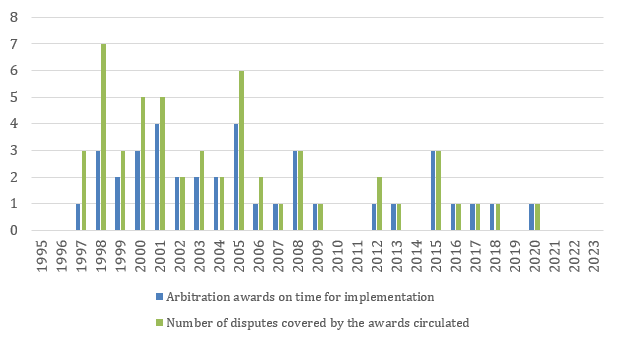
Technical note to Chart 5
For the purposes of this chart, and without prejudice to any legal implications that may be attached to the use of certain terminology, the term “dispute” refers to a matter identified by a distinct “DS” number. Where several Members have made a joint request in a single document and the joint request is assigned one “DS number”, this is counted as one “dispute”. Complaints initiated through distinct requests by different Members, with individually assigned “DS” numbers, are counted as distinct disputes even if they relate to the same matter.
The number of “disputes” covered by the Article 21.3 awards circulated may exceed the number of awards circulated, where several disputes relating to the same matter but initiated by different Members as separate disputes have been considered together in later stages of the proceedings, and a single award is circulated covering several disputes.
back to top
Compliance proceedings
Where the initial proceedings lead to a recommendation for the member concerned to bring its measure(s) into conformity with the WTO agreements, it is sometimes necessary to resort to further proceedings (so-called “compliance proceedings”) if the parties do not agree on whether compliance has been achieved by the end of the period for implementation. This involves further panel proceedings (conducted by the original panel whenever possible) and either party can appeal the findings of the compliance panel.
As of 31 December 2023, a compliance panel had been established in 52 disputes (that is, in 18 per cent of the disputes that led to the circulation of a panel report). In 33 of these disputes (that is, in 63 per cent of cases in which a compliance panel has been established), the compliance panel's report was appealed.
Chart 6 shows the number of disputes in which recourse to compliance proceedings was initiated (under Article 21.5 of the DSU), on a yearly basis, from 1995 to 2023:
Chart 6: Number of compliance proceedings (panel and Appellate Body proceedings) (Article 21.5 of the DSU)
1 January 1995 — 31 December 2023
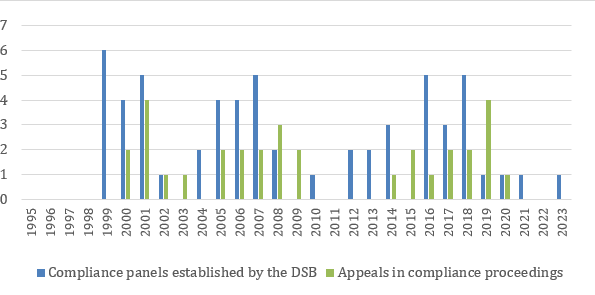
Technical note to Chart 6
For the purposes of this chart, and without prejudice to any legal implications that may be attached to the use of certain terminology, each instance refers to a matter identified by a distinct “DS” number. The number of panels established and appeals notified in this chart therefore relates to the number of distinct disputes (each identified by a distinct “DS” number) in respect of which a compliance panel has been established, or an appeal of a compliance panel report has taken place.
Where several Members have made a joint request in a single document and the joint request is assigned one “DS number”, this is counted as one instance. Complaints initiated through distinct requests by various Members, with individually assigned “DS” numbers, are counted as distinct instances even if they relate to the same matter.
back to top
Suspension of obligations
If compliance is not been achieved by the end of the reasonable period for implementation, and the parties do not agree on compensation, the complaining party can be authorized to suspend temporarily some of its obligations under the agreements towards the member concerned (retaliation). If the parties disagree on the level of retaliation, arbitration can take place to determine the permissible level of suspension of obligations. So far, every request for an authorization to retaliate has been referred to arbitration.
In most cases, compliance is achieved without a need to reach this stage of the proceedings. As of 31 December 2023, arbitration to determine a permissible level of retaliation has been initiated in 40 disputes, 21 of which resulted in at least one arbitration decision.
Chart 7 shows the number of disputes in which arbitration decisions on the level of retaliation (under Article 22.6 of the DSU) were issued, from 1995 to 2023:
Chart 7: Number of arbitral decisions on the level of suspension of obligations (Article 22.6 of the DSU)
1 January 1995 — 31 December 2023
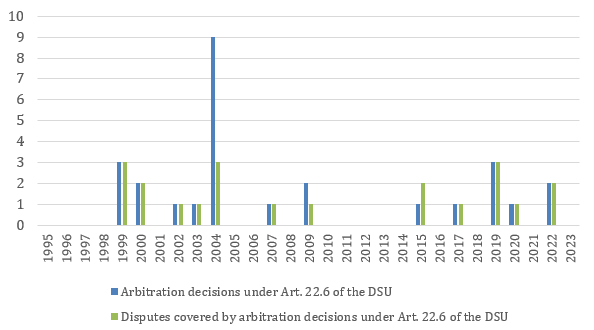
Technical note to Chart 7
For the purposes of this chart, and without prejudice to any legal implications that may be attached to the use of certain terminology, the term “dispute” refers to a matter identified by a distinct “DS” number. Where several Members have made a joint request in a single document, this is counted as one “dispute”. Complaints initiated through distinct requests by various Members, each circulated under distinct “DS” numbers, are counted as distinct disputes, even if they relate to the same matter.
The number of “disputes” covered by the Article 22.6 arbitration decisions circulated may be less than the number of decisions circulated, where a dispute was initiated jointly by various Members and assigned a single “DS” number, but one or more of these Members individually seek an authorization to suspend obligations. A separate arbitration decision is circulated in relation to each complainant having requested an authorization to suspend obligations.
*The 2004 total includes six separate decisions in DS217 and two separate decisions in DS234.
back to top
Why these numbers do not tell the whole story
In the above charts, a dispute counts as “one” instance regardless of its complexity or of how many members are involved. The “DS” number assigned to each dispute acts as an “identity card” for that dispute, and follows it throughout its existence. For this reason, it is a simple and reliable basis on which to track the evolution of disputes. However, the reality is more complex.
- It is possible for various members to bring a dispute together, under a single request for consultations. For example, the “EC — Bananas” dispute, which involved five members as complainants, counts only as one in the charts above because it was initiated by all five complainants together through a single request (all under the number “DS27”). In such a case, counting the dispute as “one” based on its “DS number” does not reveal the fact that five members, and not just one, have brought a complaint on the same matter.
- When a dispute reaches the stage of being considered by a panel or the Appellate Body, the proceedings may be conducted jointly for several disputes that were initiated separately if more than one member has initiated its own dispute with respect to the same matter. For example, three members (Australia, Brazil and Thailand) each initiated a dispute in relation to “EC — Export Subsidies on Sugar” (DS265, DS266 and DS283 respectively) and the three disputes were considered jointly both at the panel stage and before the Appellate Body.
- By contrast, if the dispute reaches the stage of requesting retaliation, separate arbitrations may be necessary for different complainants within the same dispute if they each seek an authorization to retaliate (for example, in the “EC — Bananas” dispute, two of the five “joint” complainants requested an authorization to suspend obligations, which led to two separate arbitral proceedings, both still under the “DS27” dispute. A somewhat more complex situation arose in respect of “US — Offset Act (Byrd Amendment)”, where six complainants initiated a dispute together (DS217) and two others also jointly initiated a separate request for consultations (DS234): both disputes were considered together at the panel and appellate stage, and each of the eight complainants requested an authorization to suspend obligations, leading, at that stage of the proceedings, to eight different arbitral decisions in respect of the same matter, under two distinct DS numbers.
- The level of complexity and intensity of proceedings also varies significantly from case to case. For example, in the dispute “Canada — Patent Term” (DS170), the panel and Appellate Body reports are each around 30 pages in length, and no further proceedings were required, other than a determination of the period of time for the respondent to comply with the DSB recommendations. By contrast, in the dispute “EC and Certain Member States — Large Civil Aircraft” (DS316), both original and compliance proceedings have taken place, and the original panel and Appellate Body reports were respectively over 1,000 and 600 pages.
More technical detail on the subtleties of counting disputes is provided below.
back to top
More numbers (and why dispute settlement figures can be complex to establish)
Establishing consistent counting in relation to WTO dispute settlement activity can be complicated. This is because the manner in which disputes are counted depends on how they are treated as separate or related at various stages of the process.
Disputes are initiated through a request for consultations addressed to the member (or members) whose measures are being challenged. Every request for consultations is circulated with a “DS” number, which serves to identify the dispute throughout its successive stages. This number is attributed on a chronological basis upon receipt of the request for consultations. For the purposes of the descriptions and charts above, and without prejudice to any legal implications that may be attached to the use of certain terminology, the term “dispute” is used to refer to a matter identified by a distinct “DS” number. Usually, this involves one member, bringing a complaint against one other member in relation to a specific matter.
Things get a little more complicated if several members have made a joint request for consultations in a single document. For the purposes of the figures above, this is counted as one “dispute” (because the joint request generates a single process under a single “DS” number). Conversely, claims initiated by various members in distinct documents circulated under distinct “DS” numbers are counted in the charts above as distinct disputes even if they relate to the same matter. The number of panels established and appeals in the above charts also relates to the number of distinct disputes (each identified by a distinct “DS” number) in respect to which a panel has been established or an appeal has taken place.
In later stages of the process, disputes that were initiated separately (i.e. under distinct “DS” numbers) can be joined if they in fact relate to the same matter. A single panel can be established to examine separate requests by various members relating to the same matter (under Article 9.1 of the DSU) or the same panelists can be appointed to hear initially distinct disputes on the same matter (under Article 9.3 of the DSU). A similar joining of the proceedings can take place at the appellate stage, sometimes even where the cases were not fully joined at the panel stage. As a result, the number of panels established can be less than the total number of disputes (“DS” numbers) covered by these panel proceedings (i.e. a single panel might be established to hear, for example, three initially distinct disputes). The number of separate reports circulated as a result of these joined proceedings can also vary, as each complainant is entitled to request a separate panel report to be prepared even when a single panel hears separate disputes together. All this makes the process more efficient (but the statistical work a little more complicated!).
If the dispute reaches the stage of suspension of obligations, the proceedings can be further disaggregated because each complainant seeking to be authorized to retaliate will make its own request, and a separate arbitration may be required for different complainants even if they initiated the dispute jointly under a single request for consultations.
To allow a more refined reflection of some of these nuances, a more comprehensive set of numbers is available below.
back to top
Levels of dispute settlement activity
Between 1995 and the end of 2023, 499 panel reports, Appellate Body reports and arbitral awards or decisions were circulated or notified to advance the settlement of the 621 disputes referred to the DSB by WTO members.
Over the same period, the Dispute Settlement Body, which oversees the WTO's dispute settlement activity, met over 486 times.
In practice, each dispute progresses at a different pace, so that disputes will be at different stages of the settlement process at any given time. The overall level of dispute settlement activity therefore varies depending on how many disputes are in an “active” phase in a given period.
For more information on levels of dispute settlement activity, see also:
Notes: